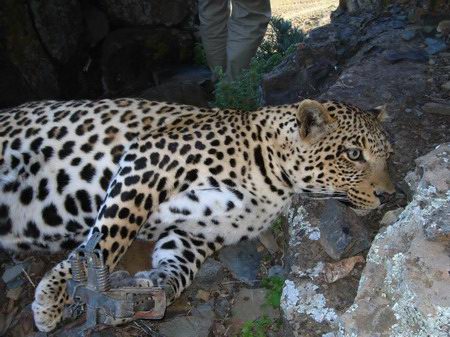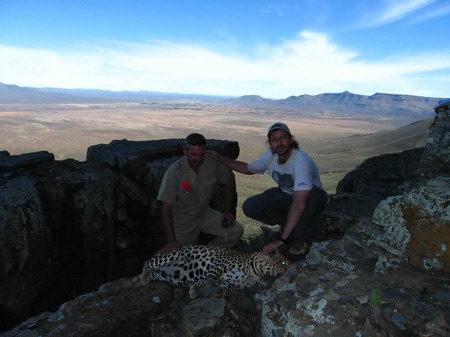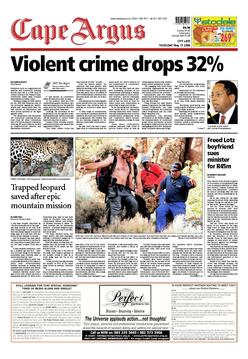The team was accompanied on the long hike to the foot of the cliffs by CLT and farm staff. There they could get a glimpse of where the leopard was hiding on a rocky ledge, 50m from the top of the mountain, on a cliff ledge a long way up. It was obvious approaching the leopard on foot on the same ledge was suicidal. So Quinton and Jaco opted to try get above the leopard in order to dart it. The vet set up all the darting equipment, and the two set off - Jaco with the tranquilising rifle and Quinton with a shotgun in the event of being attacked. They were thankfully led to an ideal spot on top of the mountain by one of the farm workers who knew the area very well.

Out of breath and very nervous, the two were able to climb onto a 1.5m-wide ledge 30m directly above the leopard who had the trap firmly caught on his left front paw. As the trap anchor had been dislodged, and the leopard was free to move at will, it was obvious there were only two ways of dealing with the situation - either to shoot the leopard and put it out of its misery, or to dart it from above, hoping he wouldn't fall off the cliff ledge once drugged. At 11am, almost 8 hours after setting out on this mission, Jaco fired a dart into the rump of what Quinton describes as "the most beautiful leopard I have ever seen". Perfect shot and then he ran towards the end of the cliff ledge, disappearing behind a bush. Now there was only one way to find out if the leopard was sedated - climbing down onto the ledge he was on, and walking in to view him.
The problem was there was only one route in and that was the escape route for the leopard if he wasn't sedated. Fortunately, the crew below could see that the leopard seemed stationary apart from his head popping up every so often." We walked in - shotgun in front, dart-gun behind. This sort of thing adds 10 years to your life. A wounded leopard (in this case by gin-trap) is one of the most dangerous animals one will encounter. And this was a large male in a difficult place. After what felt like hours, we got a visual. He was much larger than expected and obviously needed a top-up of the sedative. Jaco, an expert marksman, once again managed to get a second dart the vet had prepared, in his rump. We waited. As the drug took effect, to our horror, the leopard rolled over and slipped off the edge of the cliff into a crack.
By pure good luck, the gin-trap anchor got stuck in the crack and held him from falling further down the cliff. We quickly pulled him back up and were able to see a male leopard in absolutely prime condition with a massive stomach full of meat and a glowing golden coat. Luckily, the gin-trap used was small and had done no damage to the leopards paw other than some local swelling.
Ben-Jon Dreyer (the new Namaqualand CLT project leader), Quinton and two farm workers then proceeded to "medivac" the cat off the mountain. The vet (with mountain rescue experience) made up a stretcher from CLT t-shirts and rope, and used the gin trap as an anchor to help the team down the mountain side. Finally after many scapes, bumps and cuts the fat cat was on the back of our vehicle where a proper examination was done, tissue samples for DNA purposes and measurements were taken. Besides a traumatic experience, this leopard, a 49kg male,one of the lucky few, had survived virtually unscathed and we were able to release him back into his beautiful karoo mountain range.

Although the setting of gin-traps is generally frowned upon, we were very pleased the farmer took the trouble to contact the conservation authorities about this. Great communication between the CLT and conservation authorities has helped on several occasions regarding predator issues. We have also set up a communication in order to assist the farmer with further problems. The trap was set on the top of the mountain in order to capture a "caracal" (which was in fact a leopard) that had killed 15 of their sheep. Most gin-traps used (not all though - especially if managed properly) are quite savage and usually result in the traumatic dead of any animal caught. Also, the indiscriminate nature of gin-traps is evident in that many non-target species are captured, and often die in these traps.
Although gin-traps are banned in 89 countries worldwide, South Africa, as well as surrounding SA countries have not effected these bans. Presently there are moves to change existing legislation to improve the situation, however, calls for the outright banning of these traps may be premature. Firstly, it is unfortunately the case that the state conservation authorities in their present situation (& even the Police) would not have the capacity to monitor and effect this ban.
Almost every livestock farmer in the N.Cape has gin-traps on their farm. It would be near impossible to police the use or misuse of these traps. Secondly, the banning of these traps may very well lead to farmers seeking even less suitable methods for controlling so-called predator problems, such as poisons etc. Quinton points out that farmers in these regions do experience livestock losses due to predators, and that this delicate situation needs to be dealt with in a way where farmers are encouraged, not forced, to become part of the greater conservation goal. He
says: " as much of our countries wonderful biodiversity occurs on private farm land, it is in fact the farmers themselves, not only government conservation agencies, that are the ones who can help conserve our natural heritage. Fortunately, many farmers are already actively and successfully involved in conservation.". The best example of this is in the Cederberg Mountains, where Quinton has been running the CLT project since 2003.
"Having built up good relationships with farmers in the Cederberg Conservancy with our leopard research project, we have facilitated the very first voluntary banning of gin-trapping in South Africa by farmers in a massive area of 171 000ha. Crucially, they have also banned hunting of any kind in the Conservancy, thereby ensuring that the natural balance between predator and prey species in the wild are restored The key factor is showing farmers that our predator research is there not only for science and conservation, but also to find ways in which to help the farmer. Having an in-depth understanding of the ecology of these animals will provide us with the insight to make proper management decisions. The CLT, an NGO funded primarily by private and corporate donors have recently received funding from Conservation International specifically for a project in Namaqualand.
This work will look at predator ecology in the area as well as ways in which farmers can manage their livestock farming in order to avoid livestock depredation events. This will alleviate farmer-predator conflict and thereby eliminate the need to kill predators as well as broadly conserve this precious environment.
Media Release, pre-print version - www.capeargus.co.za - 15 May 2008

















